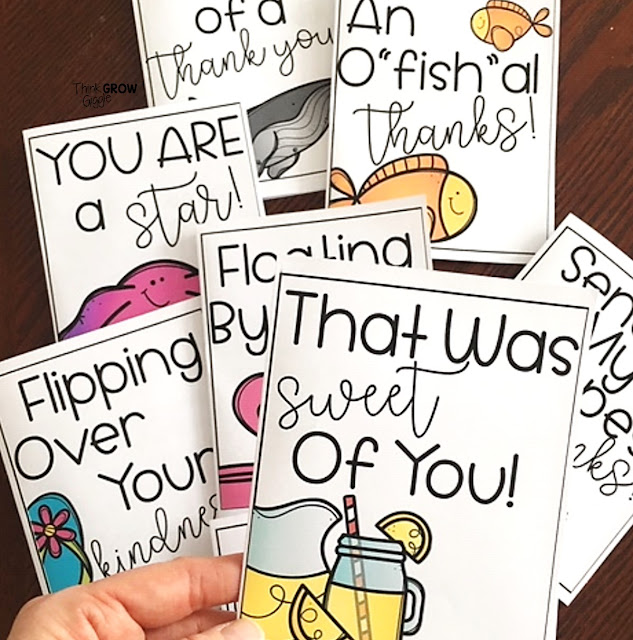I once read that one handwritten letter is equal to getting 100 emails. They are that powerful!
Thank you notes take time and truly show that you care and are grateful for something that someone else did. And why wouldn't a handwritten thank you note hold so much power? Good manners go a long way, and after all, writing thank you notes is one way that kids can show not just good manners, but gratitude, too!
I love using thank you notes in my upper elementary classroom. Over the years, I have found that there are three major benefits of writing thank you notes. Writing thank you notes throughout the year helps to:
I make writing thank you notes a part of our classroom community common practice right from the start of the school year. We write thank you notes throughout the year for different reasons. Read on to find out why we use thank you cards, different ways we use thank you cards, and some must use tips to helping your students write powerful thank you notes!
We write thank you notes for many reasons in the classroom. We express gratitude for both big and small things, to all of the important people in our lives.
At the beginning of the year we have our first lesson on how to write a thank you note and what should be included in a thank you note. (See the list of tips below for ideas.) After the first few times of writing thank you notes, the kids understand quickly when a thank you note should be written, and how to write them.
Here are some times throughout the year that we write thank you notes:
✏️ Guest speaker or presenter
✏️ Special staff member days like: custodian, secretary, volunteer, bus drivers, or any special day that takes place at school
✏️ After special school events, we thank the organizers
✏️ To family members for special days like: Grandparents' Day, Mother's and Father's Day, Thanksgiving, holiday season
✏️ To each other in class: We like to thank each other for being helpful, good friends, and an important part of our classroom community
✏️ Student ideas: The kids come up with the best ideas for sending thank you notes, ask them to share their ideas.
Try these free thank you note shoutouts, perfect for students to give staff.
Remind your students of the following tips when writing thank you
notes to help the recipient feel special:
✅Handwrite or use cursive writing in your notes to make them personal.
✅Use eye-catching paper and neat handwriting.
✅Personalize each thank you with specific information:
refer to people by name, state specifically what you are thanking them for, and
include specific information about the event or item you are thanking them for
✅Try to send thank you notes right away, but sending
anytime, even late, is better than not sending at all!
✅Take your time and make your thank you note special:
try using the recipient’s favorite colors or draw a picture that they would
love.
✅Send thank you notes as often as possible to develop good
habits, even for small, kind gestures. They make both the giver and receiver feel good!
✅Have fun and take pride in the thank you notes that
you write!
TEACHING TIP: Model how important it is to you to show gratitude through thank you note writing by sending your students thank you notes. You do not have to send students thank you notes just for gifts. Send thank you notes to students as a way to show gratitude and appreciation.
You can send thank you notes to students for many reasons like:
👍being organized
👍working hard
👍being a classroom model
👍showing kindness
👍helping an adult like a substitute
👍or any other reason, big or small, that you want to celebrate!
The more you spread gratitude, the more students will, too!
Own this set of thank you notes? Try this teaching tip: Print just the covers so that you have thank you cards with a blank inside.Now the cards can be cards kindness, gratitude, and be used for students to give to each other!
Dive in when it comes to showing gratitude and expressing thanks in the classroom!
Teach students how to write thank you notes and why expressing gratitude is important. You will not only be teaching your students important skills for the moment but you will be helping them to develop important life skills that will last them a lifetime.
Want to get started sending thank you notes in your upper elementary classroom? Grab these free thank you note templates and make sending thank yous a practice in your classroom, too!




























